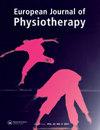Reliability of the Norwegian version of PainDETECT: a test-retest study
IF 1.1
Q3 REHABILITATION
引用次数: 0
Abstract
Abstract Objectives The PainDETECT Questionnaire (PD-Q) is a self-reported questionnaire aiming to assist in detecting neuropathic pain in individual patients. However, measurement properties of the Norwegian translated version should be examined, and the aim of the present study was to examine its test-retest reliability. Methods A total of 107 patients were initially recruited to the study from physiotherapy clinics. After screening for inclusion- and exclusion criteria, 67 participants remained for examining reliability of separate items. They were to fill out the PD-Q twice at an interval of 14 days. Intraclass correlation coefficient (ICC) and standard error of measurement (SEM) of total scores, and Kappa statistics and percentage of agreement of separate items and screening data were used in the analysis. Results Fifty-two participants filled out all items correctly, a prerequisite for determining the reliability of the total score and screening category. The ICC for the total score was 0.84 (95% confidence interval 0.73–0.91), SEM 2.5. The Kappa value for the screening category was 0.50 (95% confidence interval 0.31–0.69), and percentage of agreement 69%. Single items were found with reasonable to substantial reliability. Conclusion The Norwegian version of the PD-Q showed good test-retest reliability for the total score, but only moderate reliability of the screening category classifying the likelihood of neuropathic pain. The high number of missing answers indicates that some guidance from a health care professional is needed when filling out the questionnaire.挪威版PainDETECT的可靠性:一项重测研究
摘要目的疼痛检测问卷(PD-Q)是一种自我报告的问卷,旨在帮助检测个体患者的神经性疼痛。然而,应该检查挪威语翻译版本的测量特性,本研究的目的是检查其重新测试的可靠性。方法首先从物理治疗诊所招募107名患者进行研究。在筛选纳入和排除标准后,67名参与者留下来检查单独项目的可靠性。他们每隔14次填写两次PD-Q 天。分析中使用了总分的组内相关系数(ICC)和标准测量误差(SEM),以及Kappa统计数据和单独项目与筛选数据的一致性百分比。结果52名参与者正确填写了所有项目,这是确定总分和筛查类别可靠性的先决条件。总分的ICC为0.84(95%置信区间0.73–0.91),SEM为2.5。筛查类别的Kappa值为0.50(95%置信区间0.31–0.69),一致性百分比为69%。发现单个项目具有合理到实质的可靠性。结论挪威版的PD-Q对总分显示出良好的重测可靠性,但对神经性疼痛可能性的筛查类别只有中等的可靠性。大量遗漏的答案表明,在填写问卷时需要卫生保健专业人员的一些指导。
本文章由计算机程序翻译,如有差异,请以英文原文为准。
求助全文
约1分钟内获得全文
求助全文

 求助内容:
求助内容: 应助结果提醒方式:
应助结果提醒方式:


